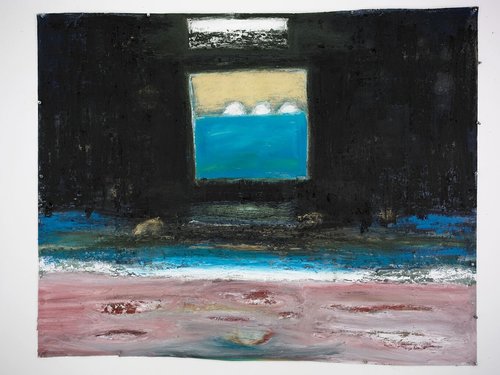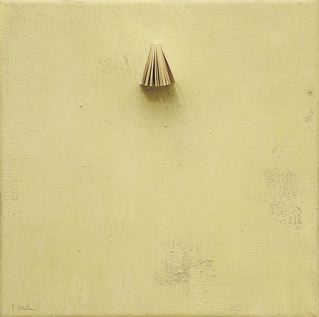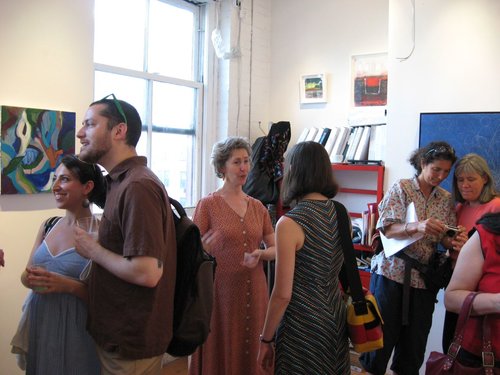by Rhonda Schaller
Create a DIY Strategy for Exhibiting Your Work: Part Four

Artwork Courtesy Rhonda Schaller
Self-Producing
When you self-produce, you are working outside of the art world structure. You find a market on your own. Many artists who self-produce work with independent curators and private dealers who are not affiliated with a particular gallery space, but might work with corporate art buyers or private clients. Venues to self produce can be anything and anywhere, including artist-run galleries and co-ops, pop up galleries, alternative spaces, juried shows, online galleries, websites, blogs etc.
Self Producing (you are in charge) vs Gallery (dealer is in charge)
Self producing means creating your own shows in a variety of spaces, exhibiting in alternative spaces, working with independent curators or artist-run co-ops.
Working with a dealer means working with a gallerist who will promote and sell your work for commission off of the proceeds of sale, normally 50%.
Advantages of being a self-produced artist
As a self produced artist, you can create relationships with Museum curators, University curators and collectors directly. You can get newspaper reviews, fringe art zines and blog write-ups directly. And you can create your own market and loyal collector base.

© Raul Emerge collection Rhonda Schaller
You control your exhibitions and what work you show and where, tailoring your market message for your style and changes in style, not sharing the proceeds of sales and choosing your price point, deciding how often you want to show, not being locked into one space or one city or one style, and making experimental work that does not rely on sales.
Advantages of being a self-produced artist can include being your own boss and creating your own opportunities. It also can include showing in alternative regional out of the way spaces that may or may not be commercial, but provide sales and a livelihood.
An entrepreneurial spirit is wonderful thing to encourage in yourself. I hate being told what to do or when, I love picking the venues, the timing, the marketing, the visuals, the invite list. Then, I either show up at the opening or not, pending on my mood. I like that freedom.
Disadvantages of being a self-produced artist and producing your own exhibits
You are your own boss, which is both good and bad, because it is up to you. You have to work at creating the work, promoting the work, marketing the brand, getting funding, etc. But you can hire or delegate tasks you do not want to do yourself. This means you can hire a grant writer or studio assistant, or manager, you can ask for help from friends, or form a buddy system with a fellow artist who you share the workload with and help fuel each other to keep going and reaching higher.
Another disadvantage is you have to create a marketing plan and stick to it, this is really important. You will need to do this as well with most commercial galleries, but always when you are self-produced. The hardest part of being self-produced, is sustaining a creative business on your own initiative. You will need to create a supportive community to help you not give up. And you will need passionate inspiring people around you to maintain your studio practice day to day.
Most important
You have to find what works for you based on your ideas about success. I can’t emphasize that enough. It can be incredibly gratifying and a lot of fun to find and make your own opportunities, to create and to manifest your vision in the world. You just take one step at a time, persevere, and replenish your spirit as needed.

Opening reception Coexistence show Rhonda Schaller studio
If you choose to self produce
Here’s what NOT to do: Stop sending sloppy packets of unorganized mis-marked jpgs with no name to every opportunity and open call you see. Stop sending out images that are blurry, poorly framed, poorly lit. Learn to say NO. You do not need to apply to every show that is listed on artdeadlines.com. You do not need to hang your work on every street corner, and waste your time, your energy and your budget on exhibitions that don’t fit your goals or make you happy.
Only send your submission when you have researched the venue and either know what the space looks like, what they show, and why they are the right fit for you and your work. Know the costs, the shipping requirements, the sitting requirements if any, and who will do what and get what, and the deadlines.
If you are creating your own show, DON’T DON’T DON’T just ask anyone to do it with you. Pick your partners based on their integrity, work ethic, and willingness to work hard for a shared goal. Make sure there is a shared goal, and learn to communicate. It’s a lot of work, and it needs to be shared. Share the marketing, the advertising, the emailing, the excitement.
Create a contact list
Who currently buys your work? Do you stay in touch with them? Do you know why they buy your work, why they love what you do? How do you cultivate those relationships, keep in touch with them, and build them over time? Remember, one purchase always leads to other purchases. It is always easier to sell to current clients than create new clients. Build on your relationships and let your collectors refer you to others.
Whenever I make a sale, I offer to bring the work to the collector’s home and hang it for them. We will sit, have a cup of tea and talk. Eventually I hang the work wherever they want it, sometimes move it a few times.
Ask your self, what other relationships do you need? Can your current collector base help spread the word about your work? As we mentioned earlier, we cannot talk about the art world without talking about relationships. All business revolves around relationships and referrals, in all aspects of business, and your art career will too.
I love this quote “Your next big break will come from someone you know. Go know people.”
What else do you need to know?
You can have a successful art career, be reviewed in magazines and newspapers, be featured in online webzines, and create and contribute to blogs. You can have a core of dedicated collectors, and find new buyers, be collected by public curators for permanent collections and make a living with your work.
You can have a day job too. The myth of the artist working without compromise is crap, in my opinion. You can be a great artist and have a day job to create economic stability while you move your career forward. You can meet your goals of success one step at a time, and not starve for goodness sake, or be less of an artist.
I’m so tired of the artists who state they are “real” artists because they work only part-time or not at all. You need to pay the bills and keep the wolves from the door, you do not have to relinquish your identity, your artistic integrity or your creativity. I have met some of my most important collectors and curators at my day jobs. I would never have met my art patron if I had not been working a day job, never been introduced to Holly Solomon or met Laura Rosenstock, senior curator in Painting and Sculpture at MoMA, if I hadn’t been working a day job, and there are many others I met along the way as well, who have been supportive and helped me continue.
Take a risk, be inventive, collaborate with others, start a movement. You are a vision-maker, and that’s a beautiful thing.
Ask yourself:
- How can I invest in myself?
- How can I reinvest in more knowledge, deeper vision, intensify my drive?
- How can I get more skilled in my art?
- What opportunities do I know about? Who will I reach?
- What compromises can I live with?
- What kind of economic base can I create to allow me to do my art and build it?
- How can I make sure my drive to succeed is not lost?
Art, as we well know, is a way of finding the true meaning of the human spirit. As an artist you are part of a tradition that allows the culture to evolve, survive and flourish. So get out there – get seen.
Also in this series:
Vision and Strategy for Artists
Alternative Opportunities for Artists
 Rhonda Schaller is an artist, gallerist, and creative/career/life coach. She is the Assistant Director, Career Development for New York’s School of Visual Arts where she teaches creative visualization, career strategies and professional development. She is the author of Called or Not, Spirits are Present published by Blue Pearl Press and contributing writer for the book Starting Your Career as a Fine Artist by Angie Wojak and Stacy Miller.
Rhonda Schaller is an artist, gallerist, and creative/career/life coach. She is the Assistant Director, Career Development for New York’s School of Visual Arts where she teaches creative visualization, career strategies and professional development. She is the author of Called or Not, Spirits are Present published by Blue Pearl Press and contributing writer for the book Starting Your Career as a Fine Artist by Angie Wojak and Stacy Miller.

Another home run article! It truly validates my choice to be self-producing and it also validates what Jim Collins says in the book “Good to Great”:
Get the right people on the bus.
Please add me to your circle of friends
Thanks Terri –
Get the right people on the bus. I love that.
This is a very good article with lots of important points to grab a hold of.
Tony Davis
Thanks, Tony. Rhonda is an expert who has written several guest blogs for Artsy Shark. Check out her guest blog from earlier this year about selling your work in NY galleries http://bit.ly/6EOWr7
Thank you SO much for this series of articles! I have been struggling lately, which is new for me, and this series has invigorated my vision again!
Brilliant!
Thank you so very much for sharing!